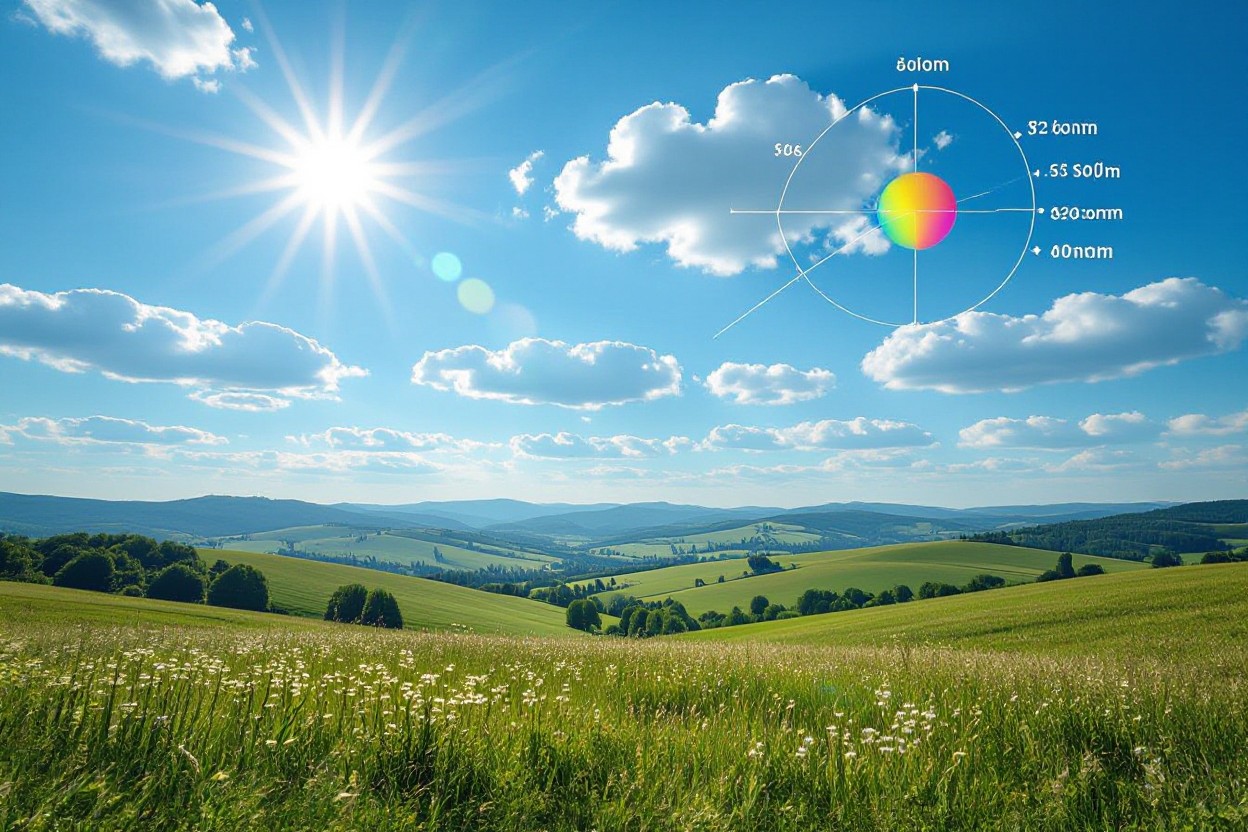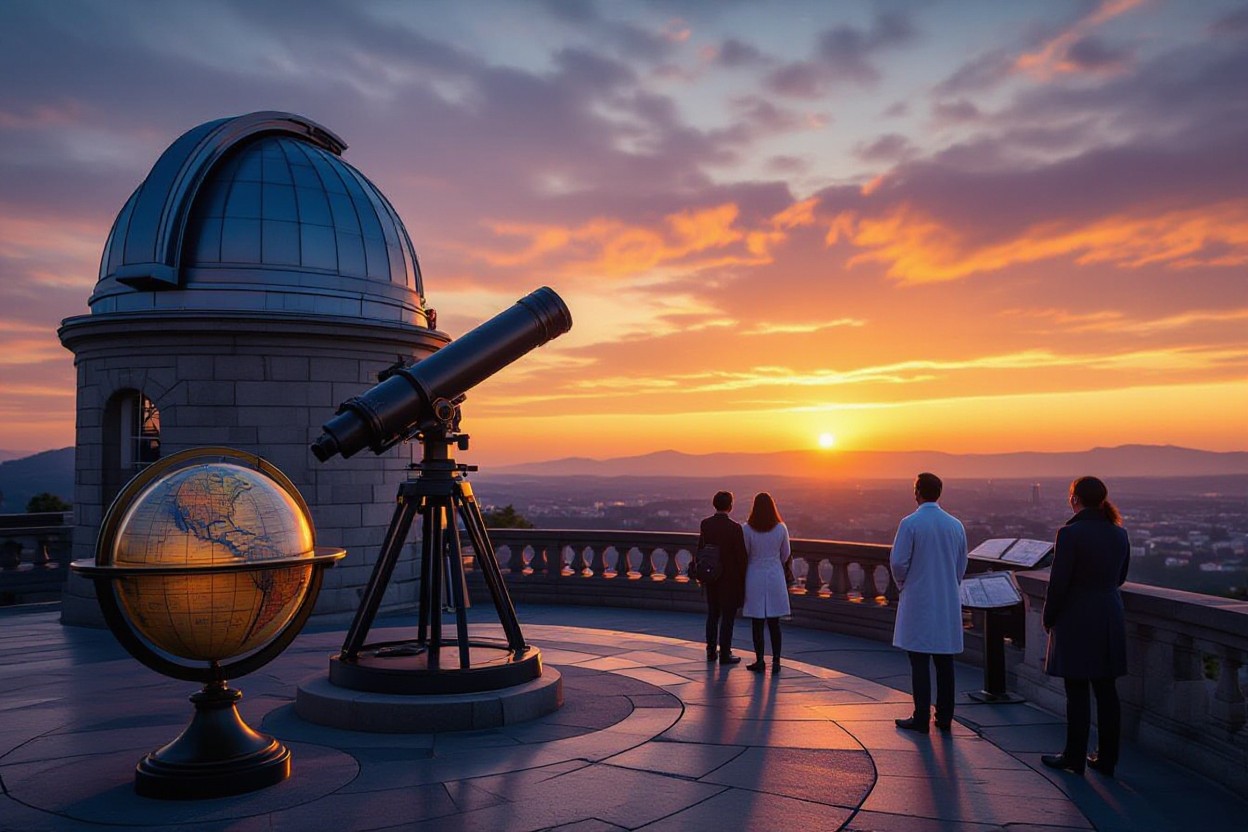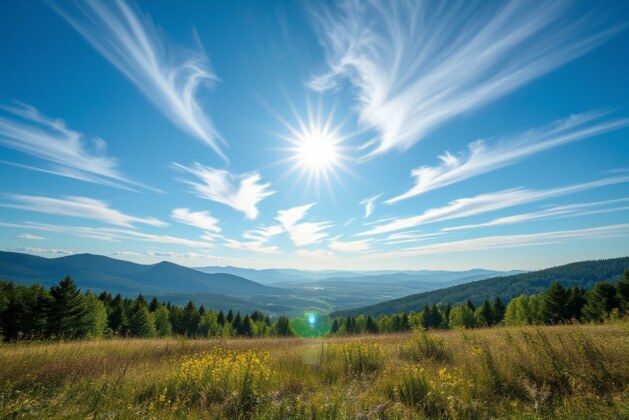Most people glance upward and accept the sky’s blue hue as a simple fact of nature, but I invite you to join me in exploring the astonishing interplay of light and atmosphere that creates this daily spectacle. As you journey through this explanation, you’ll uncover how sunlight interacts with our atmosphere’s molecules to scatter blue light more than other wavelengths. This phenomenon not only shapes our perception but also reveals the delicate balance sustaining life on Earth. By understanding why the sky is blue, your appreciation for our planet’s environment can grow deeper and more profound.

The Physics of Light: Understanding Color Perception
Light behaves like a wave and a particle, carrying energy across vast distances. Your eyes interpret this energy based on wavelength, which defines color. Colors emerge from the interaction of light with matter, influencing how you perceive the world around you. This perception hinges on both physical properties of light and biological processes within your eyes and brain, creating the vibrant visual experience you depend on every day.
The Electromagnetic Spectrum and Human Vision
The electromagnetic spectrum spans from gamma rays to radio waves, yet your eyes are tuned specifically to the narrow band known as visible light — roughly 400 to 700 nanometers in wavelength. Within this window, shorter wavelengths correspond to violet and blue, while longer wavelengths yield reds and oranges. Variations in these wavelengths dictate the hues you see, but beyond this visible range, radiation is either invisible or potentially harmful, highlighting the delicate precision of human vision.
The Process of Light Scattering in Different Environments
Light scattering depends significantly on the size and composition of particles within the environment. In the atmosphere, tiny molecules scatter shorter blue wavelengths more effectively, explaining our sky’s color. Contrast this with water, where longer green and red wavelengths penetrate deeper, altering perceived hues underwater. Various scattering types—Rayleigh, Mie, and non-selective—correspond to different particle sizes, shaping distinct visual experiences in fog, dust, or oceanic environments alike.
The contrasting scattering behaviors result from diverse particle dimensions relative to light’s wavelength. Rayleigh scattering dominates when particles are much smaller than the wavelength, accentuating blue hues as seen in a clear sky. Larger particles, such as water droplets in clouds, initiate Mie scattering, which dims color specificity and often produces white or gray tones. Non-selective scattering by even larger particles diffuses all wavelengths almost evenly, leading to a muted palette as in dense fog. Understanding these interactions allows you to predict how atmospheric conditions influence the colors you perceive daily.
Atmospheric Composition: The Role of Gases in Color Formation
The gases that make up Earth’s atmosphere don’t just sustain life; they actively shape the sky’s color by scattering sunlight. Nitrogen and oxygen dominate this aerial mix, interacting with sunlight’s shorter blue wavelengths far more effectively than longer reds or yellows. This scattering, known as Rayleigh scattering, is why you perceive such a vast expanse of blue overhead during a clear day. Yet, this balance can shift dramatically when the atmospheric composition changes, altering the visual experience we often take for granted.
Key Gases and Their Interaction with Light
Nitrogen makes up roughly 78% of the atmosphere and oxygen about 21%, both behaving as scatterers of incoming sunlight, but with a particular efficiency for the shorter, blue wavelengths. Trace gases like argon and carbon dioxide contribute minimally to this color display. When sunlight enters the atmosphere, these dominant gases scatter the blue light waves in all directions, which explains why you see that unmistakable azure canopy. This detailed interaction reveals just how delicate and finely tuned Earth’s atmospheric chemistry is to our visual environment.
How Pollution Alters the Blue Sky
Pollutants such as particulate matter and aerosols fundamentally change the sky’s appearance by increasing scattering of longer wavelengths, introducing a dull haze that diminishes the deep blue you expect. Urban and industrial emissions load the air with these fine particles, disrupting the natural preference for blue light scattering. You might notice sunsets turning a more intense red or orange, a signature of altered scattering dynamics driven by pollution. This process not only affects aesthetics but also impacts climate and human health in insidious ways.
Sulfur dioxide, nitrogen oxides, and black carbon from vehicles and factories increase airborne particles, which scatter and absorb sunlight differently compared to clean air molecules. In Delhi, for example, heavy smog episodes reduce blue sky visibility to just a few hours per year, replacing it with a persistent grayish-brown haze. Particles larger than air molecules induce Mie scattering, which does not favor blue light but spreads all wavelengths, washing out the sky’s color. This phenomenon underscores how atmospheric pollution doesn’t just mask the blue sky but actively alters the fundamental physics of light interaction with our atmosphere.

Cultural Perspectives: The Sky’s Color Throughout History
The sky’s blue hue has long been a source of wonder and symbolism across civilizations. Ancient Egyptians linked blue to divinity and protection, using lapis lazuli to emulate the sky’s shade in jewelry and artifacts. In the Renaissance, this celestial color became emblematic of purity and the heavens in art. I find it fascinating how the same sensory phenomenon—blue skies—has been transmuted into varied cultural expressions, demonstrating that our understanding of nature intertwines with human creativity and meaning-making.
Interpretations of Blue in Art and Literature
Blue often emerges in art and literature as a symbol of depth, tranquility, and sometimes melancholy. Consider the vivid blue of Yves Klein’s monochromes or the “blue haze” that envelops much of Impressionist painting, capturing fleeting atmospheric effects. Writers like Pablo Neruda have described blue as the color of desire, vastly different from more somber tones. This interplay between science and emotion illustrates how the sky’s color influences not only perception but also our innermost narratives and visual language.
Variations in Color Perception Across Cultures
Not all cultures categorize or even perceive the color blue in the same way. Some languages historically lacked a specific word for blue, leading to a merging between greens and blues in verbal description. The Himba tribe in Namibia, for instance, distinguishes fewer color categories, which affects their recognition accuracy of blue shades. Such variations reveal that color perception intertwines biological optics with linguistic and cultural frameworks, shaping how you and I perceive the sky differently based on our heritage.
Expanding on cultural divergences, research shows that the Russian language divides blue into lighter and darker shades with distinct terms—’goluboy’ (light blue) and ‘siniy’ (dark blue)—increasing speakers’ ability to discriminate subtle color differences. Similarly, the Berinmo people of Papua New Guinea categorize colors uniquely, blending blue and green concepts differently than Western cultures. This suggests your perception of the sky’s color is filtered not only through your eyes but through deeply ingrained cognitive patterns shaped by language and culture, reinforcing that science and culture jointly inform your experience of the natural world.
The Science of Twilight: Beyond Daytime Blue
During twilight, the sky sheds its ordinary blue and dances through a palette of fiery reds, oranges, and purples. This stunning transformation arises because sunlight must pass through a thicker slice of atmosphere, scattering shorter blue wavelengths away, leaving longer red and orange wavelengths to dominate your view. The interplay of atmospheric particles, pollution levels, and even volcanic ash can significantly amplify or mute these colors. This daily spectacle reveals the atmosphere’s complex role in filtering and modulating the sunlight that reaches your eyes.
The Impact of Angle and Particle Density on Color
The angle at which sunlight enters the atmosphere shifts the path length through air molecules and aerosols, directly affecting scattering intensity. Low sun angles at dawn or dusk increase the thickness of atmosphere traversed, favoring the scattering of shorter wavelengths and enhancing reds and pinks. Particle density compounds this effect by providing additional surfaces for scattering; higher concentrations of dust or pollution amplify the scattering of red wavelengths, often creating dramatic sunsets. This variable interaction causes the color spectrum to fluctuate with weather patterns and environmental conditions.
Exploring the Spectrum of Evening and Dawn Skies
Evening and dawn skies often showcase a spectrum that extends beyond simple reds and oranges, revealing subtle purples, deep magentas, and sometimes unexpected greens. This diversity results from multiple scattering events, where light rays bounce between molecules and particles before reaching your eyes. Additionally, ozone absorption in the upper atmosphere influences the coloration, filtering specific wavelengths that add complexity to the twilight hues. The specific atmospheric composition at these times crafts a layered, evolving canvas rather than a static shade.
The intoxicating purples and magentas observed during twilight emerge from the residual scattering of shorter blue light mixed with the longer red wavelengths filtering through the atmosphere. The presence of ozone absorbs some of the ultraviolet and blue light, altering the balance and enriching colors with a violet tinge. Under certain conditions, such as after volcanic eruptions, aerosols can scatter sunlight differently, producing enhanced and prolonged twilight displays. These variations allow me to witness an atmospheric symphony where chemistry, physics, and celestial positioning combine to paint your sky with extraordinary colors.

Implications of Climate Change on Atmospheric Color
Variations in atmospheric composition due to climate change significantly skew the scattering of sunlight, altering the sky’s familiar blue hue. Increased greenhouse gases and aerosol particles from industrial activity modify the way light interacts with the atmosphere. For example, elevated concentrations of black carbon and dust can absorb shorter wavelengths, diminishing the richness of blue skies. Consequently, you might notice a subtle shift toward paler or even hazier vistas, reflecting a complex interplay between pollutants and natural atmospheric constituents.
The Influence of Global Warming on Sky Appearance
Global warming intensifies evaporation and alters cloud cover patterns, directly changing light scattering dynamics. Rising temperatures elevate water vapor content, increasing the density of clouds and humidity, which can diffuse sunlight differently, occasionally muting the sky’s vibrancy. In regions like the Arctic, diminishing ice and enhanced aerosol release from thawing permafrost contribute to discoloration phenomena, sometimes lending skies an unusual shade, underscoring how warming reshapes atmospheric optics in both subtle and dramatic ways.
Predicting Future Visions: What Trends in Blue Skies May Reveal
By analyzing long-term atmospheric data and satellite imagery, scientists predict that ongoing emissions could lead to more frequent instances of duller, grayer skies due to escalating aerosol concentrations. Shifts in sky color trends serve as a barometer for air quality and climate health, where lighter blue hues may indicate cleaner air, while persistent haze suggests worsening pollution. Observing these nuances offers a tangible metric to assess the environmental impact of human activities on atmospheric clarity.
Detailed studies combining spectroscopy and climate modeling project that if current trajectories continue, urban and industrial regions will experience a steady decline in sky luminance. For example, cities like Beijing and Los Angeles have documented decreases in sky blueness correlating with pollution spikes during major smog events. Conversely, aggressive emission controls in places like Los Angeles demonstrate partial recovery of sky clarity, showcasing how deliberate policy and technology can influence atmospheric aesthetics. This ongoing research highlights sky color not just as a natural spectacle but as an insightful indicator of environmental progress or degradation.
Summing up
Ultimately, I find that the sky’s blue hue arises from the delicate scattering of sunlight by Earth’s atmosphere, a phenomenon that reveals much about our planet’s composition and the nature of light itself. When you gaze upward, you are witnessing a cosmic interplay where shorter, blue wavelengths are scattered more than others, illuminating the sky with its characteristic color. This simple yet profound effect connects us to the universe, reminding you that even everyday observations hold extraordinary scientific truths waiting to be discovered.





Leave a comment